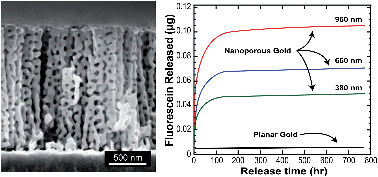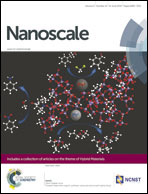Molecular release from patterned nanoporous gold thin films†
Abstract
Nanostructured materials have shown significant potential for biomedical applications that require high loading capacity and controlled release of drugs. Nanoporous gold (np-Au), produced by an alloy corrosion process, is a promising novel material that benefits from compatibility with microfabrication, tunable pore morphology, electrical conductivity, well-established gold–thiol conjugate chemistry, and biocompatibility. While np-Au's non-biological applications are abundant, its performance in the biomedical field is nascent. In this work, we employ a combination of techniques including nanoporous thin film synthesis, quantitative electron microscopy, fluorospectrometry, and electrochemical surface characterization to study loading capacity and molecular release kinetics as a function of film properties and discuss underlying mechanisms. The sub-micron-thick sputter-coated nanoporous gold films provide small-molecule loading capacities up to 1.12 μg cm−2 and molecular release half-lives between 3.6 hours to 12.8 hours. A systematic set of studies reveals that effective surface area of the np-Au thin films on glass substrates plays the largest role in determining loading capacity. The release kinetics on the other hand depends on a complex interplay of micro- and nano-scale morphological features.


 Please wait while we load your content...
Please wait while we load your content...